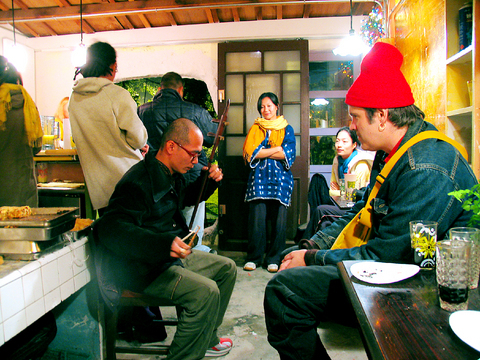The opening of a general store may not ordinarily warrant a mention in the newspaper, but the Treasure Hive, which opened its doors to the public at Treasure Hill last Sunday is part juice bar, part performance space, part soup kitchen, part grocery store, part local pub.
But it's mostly the latest chapter in the half-century saga that has seen Treasure Hill go from an anti-aircraft installation to an art installation.
"It's great to see somebody doing something here that is going to stay and to see this area revitalizing," said Yeh Wei-li (

PHOTO: DAVID MOMPHARD, TAIPEI TIMES
Treasure Hill got its start when the soldiers of the Chinese Nationalist Party (KMT) came to Taiwan.
The area was fortified and designed to protect the city's southwestern side from a Communist air attack. The soldiers stationed there built homes next to the guns they manned and married local girls.
By the time the guns were eventually removed, the area had become home and the soldiers stayed. Now there are ongoing plans to turn several of Treasure Hill's dilapidated structures into facilities that will host an artist-in-residence program.
Treasure Hive, located at the front of the community by a bicycle path that runs along much of the Danshui River, could be considered the first of the structures in the new artist community. Its proprietor, Mina Chin (覃敏怡), says she'll host weekly music performances on the lawn adjacent the store, will serve up a soup of the day, and plans to offer a variety of staple goods which she'll deliver to elderly locals.
The Treasure Hive is at 3, Alley 16, Ln 230, Dingzhou Rd, Sec. 3, Taipei (

April 14 to April 20 In March 1947, Sising Katadrepan urged the government to drop the “high mountain people” (高山族) designation for Indigenous Taiwanese and refer to them as “Taiwan people” (台灣族). He considered the term derogatory, arguing that it made them sound like animals. The Taiwan Provincial Government agreed to stop using the term, stating that Indigenous Taiwanese suffered all sorts of discrimination and oppression under the Japanese and were forced to live in the mountains as outsiders to society. Now, under the new regime, they would be seen as equals, thus they should be henceforth

Last week, the the National Immigration Agency (NIA) told the legislature that more than 10,000 naturalized Taiwanese citizens from the People’s Republic of China (PRC) risked having their citizenship revoked if they failed to provide proof that they had renounced their Chinese household registration within the next three months. Renunciation is required under the Act Governing Relations Between the People of the Taiwan Area and the Mainland Area (臺灣地區與大陸地區人民關係條例), as amended in 2004, though it was only a legal requirement after 2000. Prior to that, it had been only an administrative requirement since the Nationality Act (國籍法) was established in

With over 80 works on display, this is Louise Bourgeois’ first solo show in Taiwan. Visitors are invited to traverse her world of love and hate, vengeance and acceptance, trauma and reconciliation. Dominating the entrance, the nine-foot-tall Crouching Spider (2003) greets visitors. The creature looms behind the glass facade, symbolic protector and gatekeeper to the intimate journey ahead. Bourgeois, best known for her giant spider sculptures, is one of the most influential artist of the twentieth century. Blending vulnerability and defiance through themes of sexuality, trauma and identity, her work reshaped the landscape of contemporary art with fearless honesty. “People are influenced by

The remains of this Japanese-era trail designed to protect the camphor industry make for a scenic day-hike, a fascinating overnight hike or a challenging multi-day adventure Maolin District (茂林) in Kaohsiung is well known for beautiful roadside scenery, waterfalls, the annual butterfly migration and indigenous culture. A lesser known but worthwhile destination here lies along the very top of the valley: the Liugui Security Path (六龜警備道). This relic of the Japanese era once isolated the Maolin valley from the outside world but now serves to draw tourists in. The path originally ran for about 50km, but not all of this trail is still easily walkable. The nicest section for a simple day hike is the heavily trafficked southern section above Maolin and Wanshan (萬山) villages. Remains of